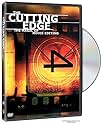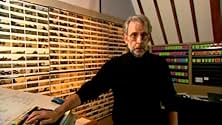IMDb RATING
7.7/10
3.3K
YOUR RATING
Documentary about the art of film editing. Clips are shown from many groundbreaking films with innovative editing styles.Documentary about the art of film editing. Clips are shown from many groundbreaking films with innovative editing styles.Documentary about the art of film editing. Clips are shown from many groundbreaking films with innovative editing styles.
Kathy Bates
- Narrator
- (voice)
- Director
- Writer
- All cast & crew
- Production, box office & more at IMDbPro
Featured reviews
This documentary is a general overview of how film cutters evolved into film editors and took their place among the giants of the film industry.
We are introduced to methods and philosophies used down through the ages and the metamorphosis from celluloid to digital recordings.
As informative as this documentary is it suffers from sound-bite-itus instead of concentrating on one person or thought, we are leaped back and forth through a collage of people, techniques, and time. This method of presentation can become quite boring after a time. Still, the documentary (that only shows highlights and nothing practical) is worth viewing.
We are introduced to methods and philosophies used down through the ages and the metamorphosis from celluloid to digital recordings.
As informative as this documentary is it suffers from sound-bite-itus instead of concentrating on one person or thought, we are leaped back and forth through a collage of people, techniques, and time. This method of presentation can become quite boring after a time. Still, the documentary (that only shows highlights and nothing practical) is worth viewing.
Do you know of the importance of the Film Editor to making a great film or to leave the best on the cutting room floor? Did you know that Spielberg & Scorcese will not let any Actor into the Cutting Room (but that Sean Penn will do so)....that earlier there were "Basic Rules" to editing but that the rules went asunder under the French "New Wave"! PLEASE: Ignore the low score and note that almost all viewers gave this documentary either a TEN or a one....and we all know that there is a small percentage of IMDb'ers that truly HATE films and will do anything in their zeal to burn their path of ignorance behind them in an effort to bring everyone to their level of ignorance. How sad to disdain our basic need to learn about life and specifically to learn about what make a Great Film what it will become.
8donf
This is a remarkable documentary, informative, interesting and successful in clarifying what is, for many, something of a mysterious process. The contributions to film making of directors, actors, designers, cinematographers and sound recordists is self evident, but the film editor's role has seldom been understood nor its importance fully recognised. This documentary is the first to give directors and editors an opportunity to explain exactly what goes on in the editing room and they have done it superbly. What a pity then, that references to the history of film editing woven into this story are cursory, inadequate and in some instances completely wrong. Martin Scorsese refers to Edwin Porters' 1902 film, Life of an American Fireman, as the very first film to be edited using crosscutting as a structuring device, and the commentary supports this view, despite convincing evidence to the contrary that was discovered in 1978. In fact the earliest discovered examples of this practise date from 1906. Equally mistaken is the assertion, made several times in this prize-winning documentary, that D.W.Griffith originated the important editing practise of action matching. In fact there is clear evidence of action matching in a British film made as early as 1903 and Griffith's first film was not made until 1908. There is considerable evidence that Griffith considered action matching to be of very little importance, and when used in his films it is often ill judged and clumsy. All this is curious in a documentary that seeks to explain the history and practise of film editing. One might have expected research on the topic to be as well informed as the comments made by most of the contributors, particularly given that the scriptwriter is Professor Mark Jonathan Harris of the School of Cinema and Television, University of Southern California.
This is one of the two feature-length documentaries on the 2-Disc Special Edition DVD of Bullitt. With a running time of 95 minutes, it is the longer one, by about 12 minutes. It consists of interviews and film clips(old, new, fiction, documentary(including propaganda works), famous and unknown, and a little real life footage; note that there are spoilers for many of the movies) used as examples or such, and narrated well by Kathy Bates. It is ironic that the invisibility and underrating of the role of the editor is somewhat shown by the fact that a couple of the directors here are actors first(big names, of the kind that draw attention), but other than that, I can say nothing negative about this. Everyone here has something to say(no, I know, I didn't expect much from Rob Cohen, the man behind xXx, either), and those who have the most to offer genuinely *are* the ones we see for the majority of this. Speaking as someone who *loves* the art of cutting, I can't say if this will be as compelling to those who aren't into the craft, however, this is clearly made for said group, and if you find yourself in it, you will not regret watching this. Before seeing this, I would not have dared suggest that one could successfully tell the history of its development and cover this amount of ground on the "theory" of it(like the line I quote in the summary, to give just one example) in a mere hour and a half. The whole thing is extremely interesting and informational. It has a great sense of humor without trying too hard. The numerous analogies and the like are excellent. As is fitting for the subject, this is put together rather well. There is a little strong language in this. I recommend this to anyone who wants to know more. 8/10
Very fine feature length documentary lurking amidst the extras on my Bullitt Blu-ray disc. Little direct relevance to that film except that it did win an Oscar for editing and we do get to see some of the famous car chase. But never mind, all the better for not being directly related for this is a far reaching and informative piece. Kathy Bates narrates the early b/w footage and informs us that women were the first editors. It was considered somewhat related to sewing and stitching we are told and therefore appropriately relegated to ladies until sound came in and men had to be involved because that was far too technical. Before we have a chance to remonstrate we have Tarantino introducing his beloved editor Sally Menke and all is sweet and light. I had never seen Menke or fellow editors Walter Much, Craig McKay and others before and cannot even recall seeing Alexander Payne, Joe Dante or Lawrence Kasden, three of the numerous directors who also put in their pennies worth plus great little anecdotes. Informative, fast moving, colourful and of course, well edited.
Did you know
- TriviaThis documentary is featured on the Two-Disc Special Edition DVD for Bullitt (1968), released in 2005.
- Crazy creditsEmbedded throughout the beginning of the credits are photos of several film editors displaying the awards that they've won.
- ConnectionsFeatures L'Arroseur arrosé (1895)
- How long is The Cutting Edge: The Magic of Movie Editing?Powered by Alexa
Details
- Runtime1 hour 39 minutes
- Color
- Sound mix
- Aspect ratio
- 1.85 : 1
Contribute to this page
Suggest an edit or add missing content

Top Gap
By what name was The Cutting Edge: The Magic of Movie Editing (2004) officially released in India in English?
Answer





























